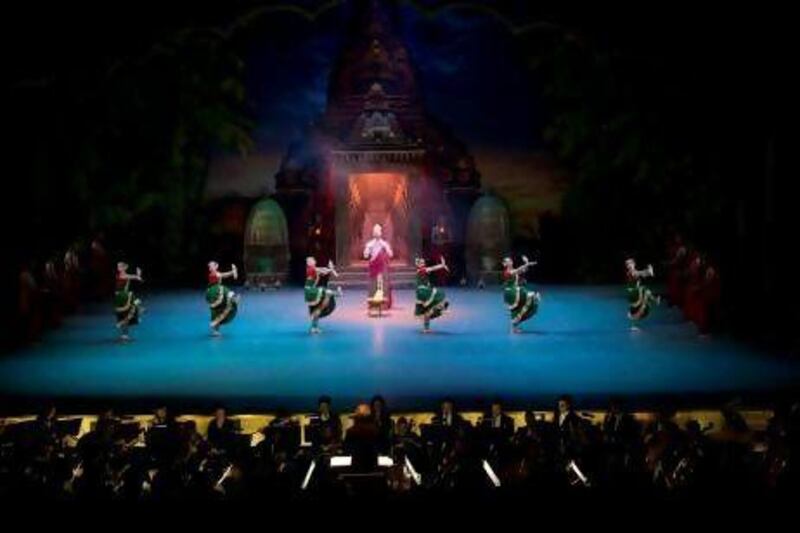La Bayadère - The Temple Dancer - is a wonderful case of better late than never.
The romantic ballet cemented itself as a classic in its native Russia since its premiere in 1877 but it didn't make it to the west until the 1960s. With borders and artistic barriers heavily guarded, the credit for this cultural smuggling goes to two defectors from the Kirov Ballet: Rudolph Nureyev and Natalia Makarova.
With their own respective productions stretching from Europe to the US, interest in the ballet swelled so much that it grew from being performed in fragments to its full-length revival in 2000. Since then, it has been performed regularly by famed ballet companies, including The Mariinsky Ballet and the American Ballet Theatre.
However, it was a younger set performing the classical piece on Saturday night at the Emirates Palace Auditorium.
In the last of its two-night stand, audiences were charmed by the Semperoper Ballet's luscious rendering of La Bayadère. From the colourful stage design denoting ancient India, the Dresden ballet company channelled all the love, intrigue, jealousy and rage of the story with a dynamic performance.
The inclusion of La Bayadère as part of the Abu Dhabi Festival was an inspired choice, as it plays well to seasoned and first-time ballet watchers. For the latter, the plotline was easy to follow (the hefty programme book also helps) and dancers did an exemplary job on a performance that was heavy on both emotion and technical virtuosity.
Ralf Arndt was a towering presence as Raja Dugmanta, as he marauded the stage conveying his fury at his son, Solor's, hidden love affair. Jirí Bubenícek also gave emotional resonance as Solor. Where he could have easily portrayed the noble warrior as a macho hunk, he remained expressive throughout in a role that sees his emotions transform from unbridled joy to deep despair.
For the trained eye, it was the delicate balance of the full points and evocative arabesques that were responsible for the delight.
The movement of Solar's competing love interests spoke of the drama. Nikiya (Natalia Sologub), the spiritual temple dancer, was a mixture of the modest and feline. Sologub inflects her arabesques with added sensuality and after Solar's deep betrayal, her movements become more frayed and frantic.
Meanwhile, her rival, the Raj-approved Hamsatti (Sveltana Gileva) portrayed her character with pristine yet aloof movements. In the finale, however, she displays graciousness as she discovers Solar's heart belongs to another.
The British composer David Coleman's score was captivating. With the NDR Radiophilharmonie Hanover, he underscored the Indian setting with beautiful floral passages in the first act before becoming more rhythmic and exploding in an impressive torrent of cymbals and percussion in the final act when the temple is destroyed in heavenly fury.
A treat for the senses, La Bayadère delivered something for all.
Follow
Arts & Life on Twitter
to keep up with all the latest news and events
[ @LifeNationalUAE ]






